Yet, despite how effective referrals are, most businesses stop at a basic discount for referrals, missing out on strategies that turn customers into evangelists. That’s why I’m breaking it all down for you. In this blog post, I’ll show you how to build a high-impact client referral program — and why it can transform your business.
Let’s get started.
Table of Contents
What is a referral program?
A referral program is a structured word-of-mouth marketing strategy that rewards customers for advocating on behalf of your brand. Instead of relying solely on online reviews or feedback surveys, referral programs encourage customers to directly recommend your brand to people they trust.
Let’s say I find my favorite spot for coffee and sandwiches. The very next day, I bring a friend along, and the business owner recognizes me. After a few more visits, I’m no longer just a customer — I’m a regular. Over time, my loyalty earns me perks, maybe a free coffee or a discount.
That’s the essence of a referral program. Businesses reward customers not just for returning but for bringing others along.
How do referral programs work?
A customer referral program rewards existing customers for referring new ones. To track these referrals, most businesses use lead generation software, which assigns unique referral links to customers.
When a new customer completes a purchase using one of these links or a code, the referring customer earns a reward, often a discount, gift card, or promo code. This cycle of referrals fuels business growth because personal recommendations build trust, making customers more likely to convert without additional marketing spend.
Take Dropbox, for example. Their referral program rewards both the referrer and the new user with extra storage. I once invited a few colleagues, and before I knew it, I had enough free space to back up all my important files. It felt like a win-win; I got more storage at no cost, and my colleagues discovered a great tool for file storage and sharing.
That’s the beauty of referral programs: They create a self-sustaining growth loop where happy customers bring in new ones, boosting revenue with minimal effort from the company.
However, referral programs should not be confused with affiliate programs. While referrals rely on personal connections and trust, affiliate programs are more transactional, with third-party advocates promoting to a broad audience for commission.
How valuable is a referral?
Customer referrals are highly valuable because they come from a trusted source, convert at higher rates, and don’t cost much to acquire. The exact value of a referral varies by business, but a simple way to estimate it is by adding a customer’s lifetime value (LTV) to the cost of acquiring them (CAC) since a referral saves you that cost while still bringing in full LTV. That’s free growth.
Think of the last time you tried a new restaurant or bought a product because a friend recommended it.
That moment didn’t just make you a customer. It made you part of a larger network of shared recommendations. I know this because I have done the same thing. When I find something great, I can’t help but tell my friends about it.
This ripple effect isn’t just anecdotal. New research confirms it: Customers who discover a brand through word-of-mouth are 31-57% more likely to introduce others, setting off a powerful chain reaction of organic growth. I call this the “pass it forward” effect because one recommendation turns into many.
The benefits don’t stop there. Data from the same research shows that these customers convert 30% more often, stay loyal 37% longer, and generate 16% more in LTV than those acquired through traditional marketing.
Brands that master word-of-mouth marketing don’t just gain customers. They build a base of dedicated advocates who bring in more like them. In turn, those customers are also more likely to advocate for your brand because personal recommendations feel natural and socially appropriate. They are simply passing along the same helpful advice that brought them in.
When word-of-mouth fuels growth, you are not just acquiring customers; you are turning them into an extension of your marketing and sales team. That means handling these relationships with care, consistency, and patience.
I have learned that if you treat recommendations as a passive channel, you are missing a major growth opportunity. But if you nurture them, the results compound.
How to Create a Customer Referral Program
- Start with customer referral templates.
- Set your goals.
- Research how referrals are coming to your business.
- Determine what a 'good fit' is for your company.
- List possible customer referral sources.
- Identify channels to host your referral program.
- Identify your referral incentives.
- Make a plan to reach out.
- Create resources to alert your customers.
- Set up tracking.
- Follow up on your referrals quickly.
- Say Thank You.
- Improve your referral program.
1. Start with customer referral templates.
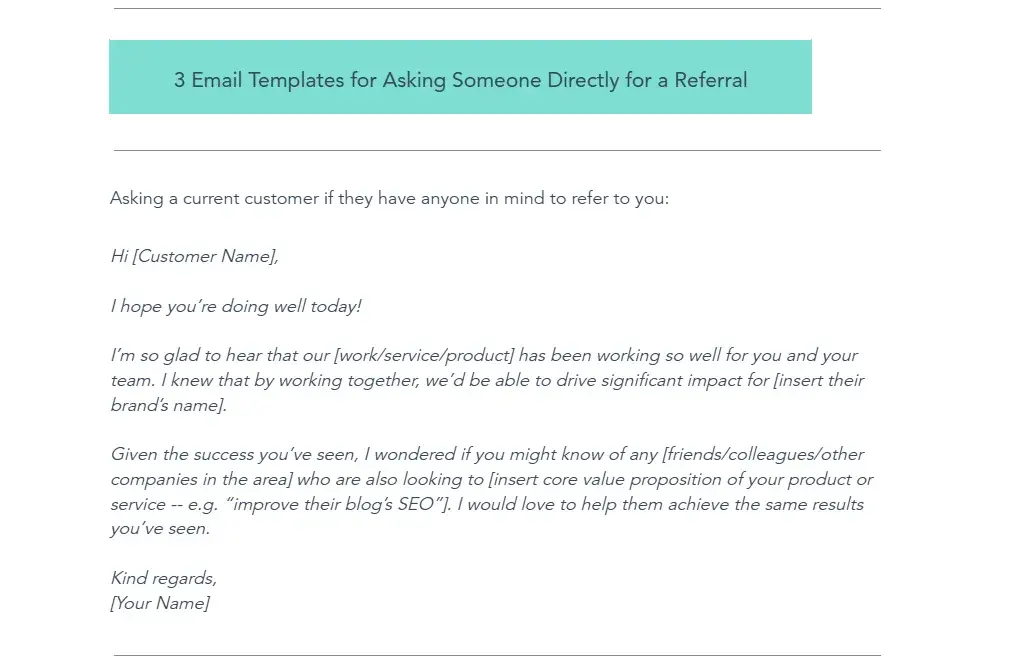
Whether you’re a one-person referral machine or part of a full-on referral team, I recommend starting with a library of referral templates to streamline your operations and get more referrals.
Not only do templates save time but they also ensure you’re following best practices right from the start.
I find that templates also keep your messaging consistent and can be tweaked to match your brand’s voice and tone. Plus, they make it easy for anyone on your team to jump in and use them when needed.
These free customer referral templates can help you build a go-to resource bank for things like:
- Referral request emails. A simple, effective way to ask customers to refer you.
- Referral follow-up emails. Because sometimes, people just need a little reminder.
- Social media copy. Quick, shareable posts to spread the word about your referral program.
- And more! The right templates keep your referral program running smoothly without you having to reinvent the wheel every time.
With these templates as your foundation, let’s build out the rest of your referral program strategy.
2. Set your goals.
I recommend asking yourself: What specific outcomes do you want from this referral program? In my view, the clearer your goals, the more effective your program will be.
- Are your goals tied more to growth and revenue?
- Do you want to add retention to that mix?
- Are you in an industry that requires an exceptional amount of trust-building?
Without clear goals, you risk building a client referral program that doesn’t serve your business needs.
Once you decide what your goals are and explicitly define them, you’ll know whether to focus on incentives, customer experience, or trust-building strategies.
3. Research how referrals are coming to your business.
A good place to start is by assessing where and how referrals are coming to your business — or if they’re coming at all.
I strongly advise establishing this baseline first. Without it, I believe you’ll be building your customer referral program in the dark, wasting time, misallocating resources, and missing high-value opportunities.
This is where you should involve marketing, sales management, support, and anyone responsible for building customer relationships.
Assess how they’ve traditionally handled referrals:
- What’s working?
- What types of referrals convert best?
- What’s falling through the cracks?
- Slow response times, unclear incentives, or lack of follow-up?
This will give you an idea of where you already are.
You should also know what an existing customer is worth. Compared to time spent monitoring and managing onboarding programs, how many referrals do you need to break even? Do the math.
If an average customer brings in $X in revenue and you gain Y% of new business through referrals, how many do you need to justify your investment?
See the potential. Then, adjust your marketing spend accordingly.
4. Determine what a “Good Fit” customer is for your company.
If you want high-quality referrals, start by defining exactly what an ideal customer looks like. Without this clarity, you risk a flood of low-quality leads: people who won’t convert, won’t stay, and won’t bring value to your business.
I’ve seen too many businesses waste time chasing the wrong leads simply because they skipped this step and failed to set clear referral guidelines.
With clear referral guidelines, customers won’t just submit random names to cash in on incentives. Instead, they’ll connect you with high-quality leads, people who are actually likely to buy. When referrals align with your ideal customer profile, they create stronger relationships, higher retention rates, and long-term revenue growth.
I always tell businesses that the best referrals come from clarity. When people know exactly who to send your way, they don’t just make introductions. They make the right introductions.
Make these descriptions impossible to miss. Feature them prominently on your referral form, landing page, and email invitations so referrers never have to guess. Spell out exactly what a “good fit” customer looks like right at the top in clear, unmistakable terms.
Reinforce this with a quick checklist or a one-sentence description so referrers can instantly qualify their leads without second-guessing. This ensures referrals connect you with people who genuinely need your product, not just a friend who “might be interested” but someone actively searching for a solution like yours.
By refining your referral strategy with clear criteria, you position your business for sustainable success while also making it easier for customers to send the right people your way. The most successful referral programs don’t just offer rewards. They teach referrers exactly who to refer to, ensuring quality over quantity every time.
5. List your possible referral sources.
I consider your referral sources a secret weapon for growth.
They’re your advocates, and in my experience, they include anyone you’re already connected to or have been in the past. Think about current customers, past customers, leads that didn’t close, industry leaders, and even your vendors. These are the people who already know, like, and trust you, making them prime candidates to send business your way.
Starting with this list gives you a clear advantage. When you know where to look, referrals get a whole lot easier.
6. Identify channels to host your referral program.
For your customer referral program to succeed, you’ll need a communication platform that keeps everyone in the loop, alerting both your business and the referred customer when they submit a referral. This ensures quick follow-ups, a seamless experience, and higher conversion rates.
A great example of this is Uber Eats. Their referral system makes sharing effortless by allowing customers to send referral codes via WhatsApp, Messages, or other apps. When a customer refers a friend, the friend receives a unique discount upon signing up, while the referrer earns a reward after the first order is placed.
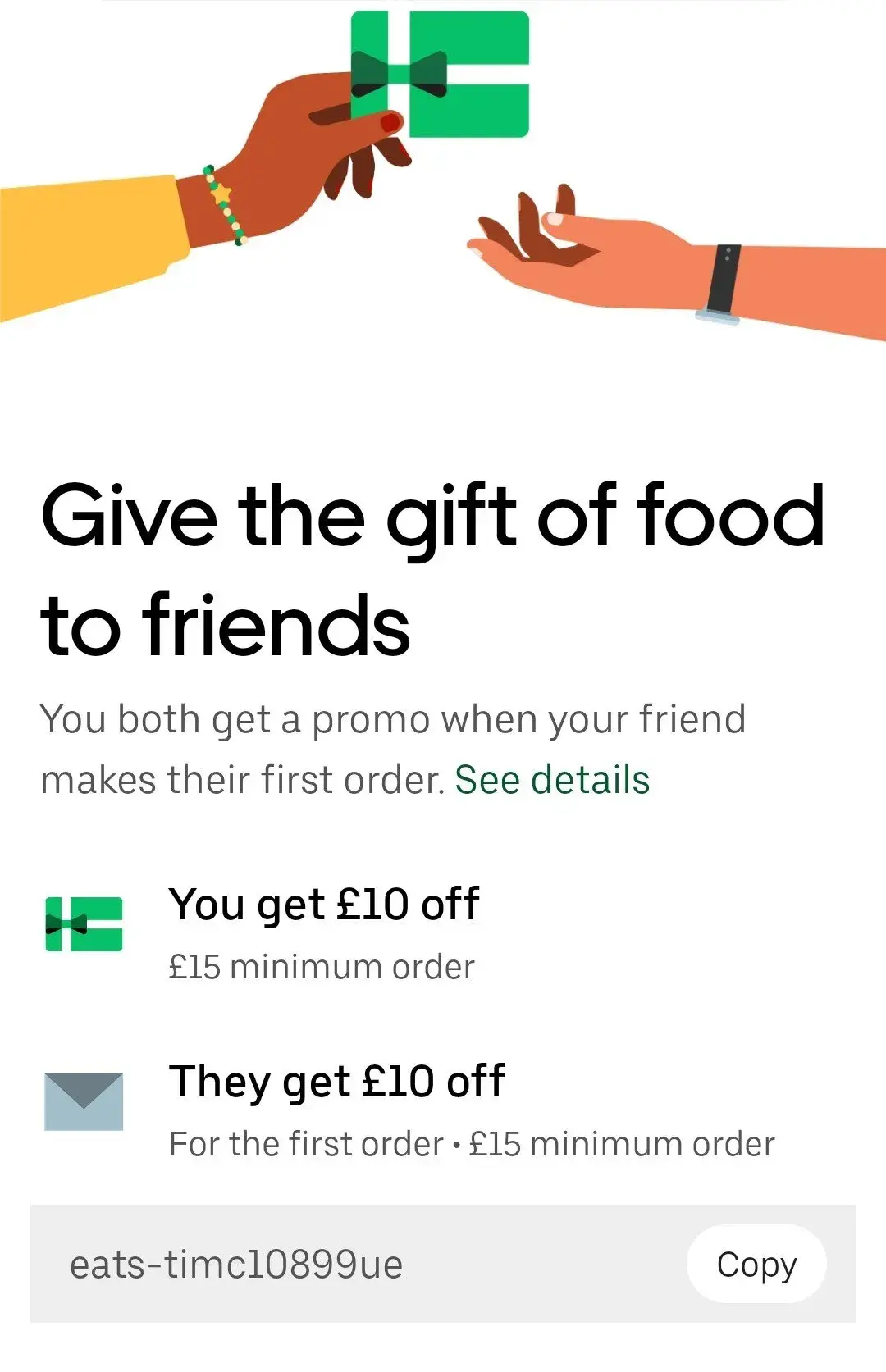
The app tracks referrals automatically, ensuring transparency and making it easy for users to see their rewards.
By implementing a similar system, you can streamline referrals and create an incentive-driven experience that keeps customers engaged.
7. Identify your referral incentives.
There are two types of referral programs: incentive-based and non-incentive-based.
I suggest breaking your contacts into different levels at this stage. From what I’ve observed, not everyone needs the same type of incentive to refer others. Some people need a little extra motivation, like a discount or reward, while others will refer you simply because they believe in what you do.
I’ve also found that knowing who needs an incentive and who doesn’t can make all the difference.
Incentive-based Client Referral Programs
If you want to actively encourage referrals, an incentive program is the way to go. This means offering something in return, like discounts, store credit, or even cash, for both the referrer and the new customer.
In our UberEats example above, when a customer refers a friend, they get a $15 credit, and the new customer gets $20 off their first order.
It’s a win-win that keeps people excited to spread the word.
Non-incentive Client Referral Programs
Not every referral needs a financial reward. Some of the best referrals come from happy customers, industry peers, or personal connections who genuinely believe in your business. In those cases, instead of offering a discount, I’d recommend that you give VIP perks, exclusive access, or even just a heartfelt thank you note. Honestly, a little appreciation goes a long way.
Whatever approach you take, make sure the referrer benefits, too. Referrals work best when both sides feel good about it.
8. Make a plan to reach out.
I recommend starting by refining your source list. In my experience, it’s best to narrow it down to your inner circle — the people who truly understand your business’s value. From what I've seen, these are often the ones who will refer you without needing incentives.
When creating your outreach plan, finding your inner circle isn’t something you can automate. You’ll get way better results by manually pulling and segmenting these contacts. It takes more effort, but trust me, it’s worth it.
Once you have that list, there are two key things to keep in mind.
Timing is everything.
Think about when it makes the most sense to ask these inner-circle advocates to participate in your referral program. Since they already know and trust you, the ask is easier — but timing still matters.
When you start working with people who need an incentive (more on that below), the relationship becomes even more important.
Some businesses should wait until later in the customer relationship to ask for a referral — especially for high-ticket services. For others, like apps or digital platforms, it makes sense to ask right after the first sale.
And once you’ve asked? Be patient. You might need to wait months — or even a year — before following up and reminding them about your customer referral program again.
Be picky with your advocates.
Even within your inner circle, not all referrals are created equal. You want people who will represent your brand the right way.
Ask yourself:
- Who do I have a stellar, stand-out relationship with?
- Do I have an existing customer who came from a referral and turned into a great client?
- Who genuinely understands my business and can market it well to others?
And one more thing — watch out for referral fatigue. You don’t want to overburden your contacts by asking too often. Keep it natural, keep it strategic, and make sure they feel valued.
9. Create resources to alert your customers.
I cannot emphasize this enough: Once you’ve got your referral program in place, you need to get the word out effectively. I’ve found that even the best referral program won’t succeed if people don’t know about it. Here’s what I recommend for promotion.
Go beyond just a one-time email blast. A single email won’t cut it. Instead, use multiple channels to keep your referral program top of mind:
- Newsletters. Subtly remind customers on a regular basis.
- Blogs. Share success stories and highlight why referrals matter.
- CTAs & Email Signatures. A simple line in every email can go a long way.
- Product Updates. Tie your client referral program into new features or improvements.
Once you’ve outlined your referral program, you’ll know exactly what resources you need. Here are a few essentials:
- Emails for each type of contact explaining the referral program.
- A message that helps your customers understand who would be a great fit for your business. You want to paint a clear picture of your ideal customer.
- A workflow that guides your contacts through the referral process and alerts your sales team when to follow up.
- A landing page where referrals can be submitted easily.
- Scripts for your sales and customer support teams so they can confidently explain the program.
- A referral kit packed with shareable resources — think case studies, testimonials, ebooks, videos — anything that gives insight into working with your business.
Whatever channels you use, make sure your messaging is consistent, persistent (but not over-the-top), and fully aligned with your revenue, growth, and retention goals.
At the end of the day, a referral program isn’t just about asking — it’s about making it easy, obvious, and rewarding for people to refer you.
10. Set up tracking.
I strongly recommend implementing a solid tracking system, regardless of your company size. In my analysis, this becomes even more critical as your customer base grows. That way, you won’t miss a single referred account or any of the details that come with it.
Here’s what I suggest tracking:
- Who was referred, and who referred them?
- When they were referred.
- If they converted or made a purchase.
- What does your follow-up and nurturing plan look like?
In my experience, a CRM makes all of this easier. If you haven’t already invested in one, now’s the time to start.
A well-managed CRM isn’t just about organization. It’s about customer success. When your customers feel like valued individuals, they stick around longer. Personalization fosters loyalty, and that loyalty directly impacts retention and revenue.
11. Follow up on your referrals quickly.
When you land a solid lead, act fast. Referrals won’t wait around forever, and if you hesitate, you might lose them.
Just because a customer referred someone to you doesn’t mean you’re the only business they recommended. That lead could be weighing other options. Plus, you don’t know how much research they’ve already done. They might be leaning toward a competitor, and it’s on you to give them a reason to choose you instead.
The sooner you make an impression, the better your chances of closing the deal.
12. Say, “Thank you.”
Thank the referrer for helping you out (this is where incentives might work, but also consider sending a thank you message), and thank the referred customer for joining.
Then, get to work — you’ve got happy customers to prove right.
13. Improve your referral program.
As I mentioned earlier, there’s no universal blueprint for creating a perfect customer referral program. Depending on how you assess customer needs and preferences, the best program for your business will be unique and potentially quite different from your competitors.
The key takeaway is that you should expect to spend time figuring out what works and what doesn’t. I recommend viewing your program as a continuous experiment: Test, measure, and adapt based on the results.
Send your customers feedback surveys to learn what they think about your program. Then, be sure to apply that feedback. After all, the better your referral program is, the more leads it will generate for your marketing and sales teams.
Now that I’ve explained how to create a referral program, let’s explore some of the benefits of having an effective program.
Benefits of Customer Referral Programs
As I mentioned in the previous section, customer referral programs are a win for all three parties involved.
Existing customers get rewarded for their loyalty, new customers gain a trusted recommendation, and businesses acquire high-quality leads at a fraction of the cost of traditional marketing.
In fact, referrals tend to convert better, stay longer, and spend more — making them one of the most profitable acquisition channels.
Let’s break down why referral programs are a goldmine for businesses.
Attracts Warm Leads Through Trust
With a plethora of brands competing for the same customer segments, it’s hard to earn their trust and convert them into potential leads. Online reviews are less credible than they used to be, probably because of the fake reviews.
That’s when customers turn to more credible word-of-mouth marketing from friends or family. Recommendations from a known person earn a higher grade of trust than online forums or ads.
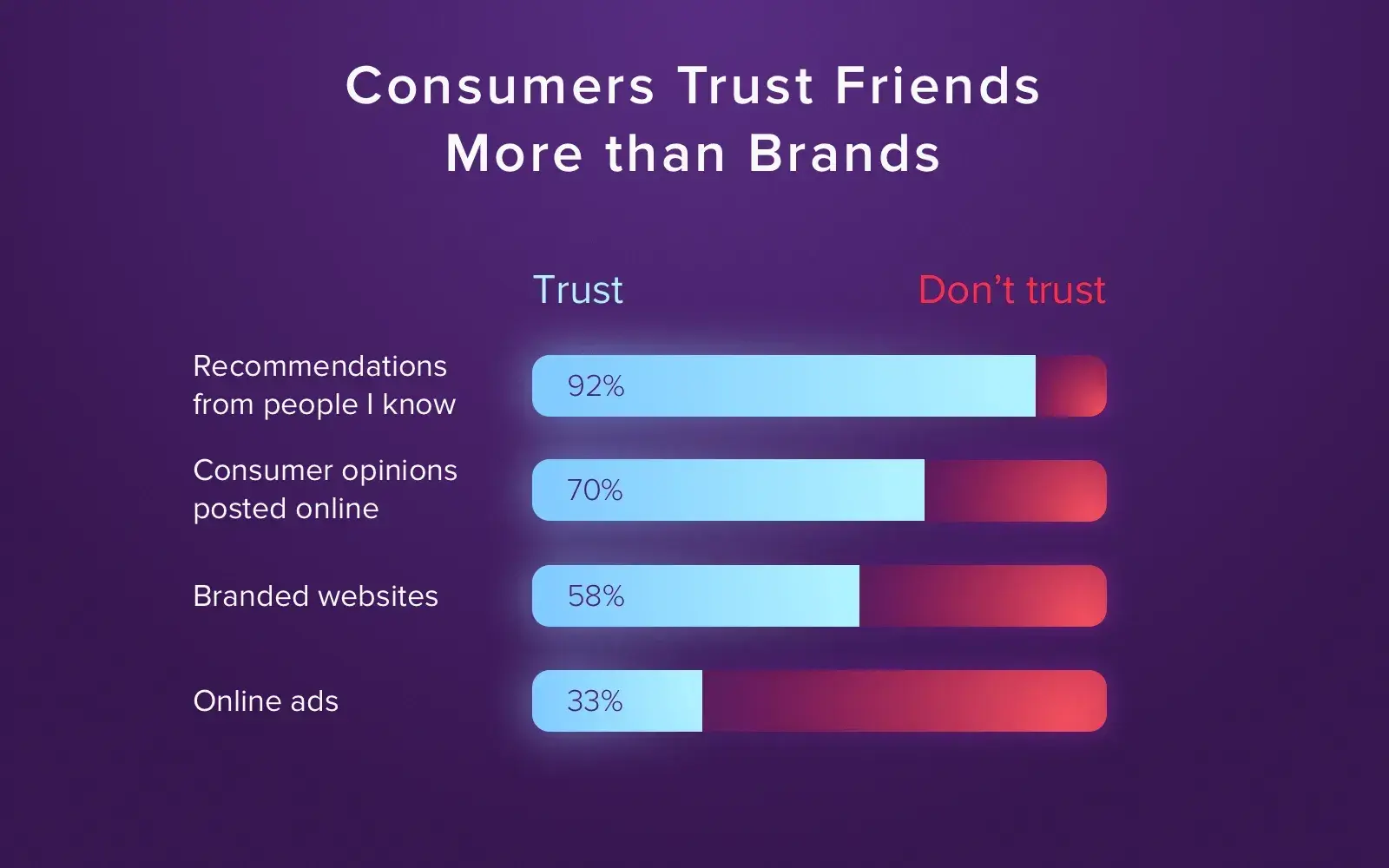
For example, a person would recommend an automobile service that they have already used and know about what they have to offer. This way, a qualified lead has already been sent your way rather than spending on converting the cold leads.
Lowers Customer Acquisition Cost
From my analysis of various marketing channels, I’ve found that referral marketing is one of the most cost-effective strategies. I recommend it particularly because it typically requires minimal marketing expenditure while delivering high-quality leads.
The only costs associated with customer referral programs are launching the program and rewarding referrers for brand advocacy. In return, you get warm leads who are more likely to bring you new customers through referrals.
Popular cloud storage service Dropbox gained a whopping 4 million users in just 15 months, with 35% of all sign-ups coming from the client referral program.
And what do they have to offer? A storage of up to 500 MB for two. In my opinion, that’s a great deal in exchange for a new paying customer.
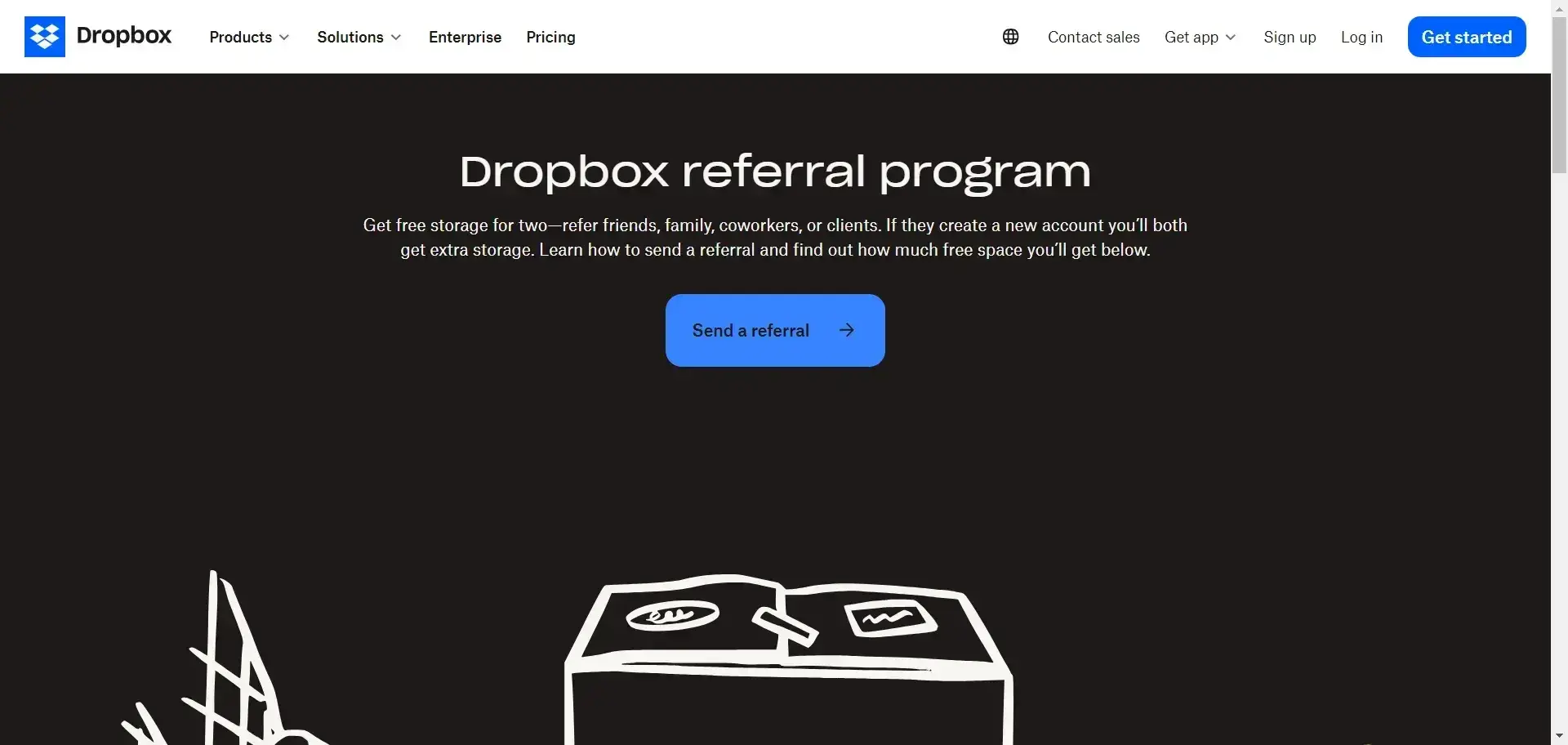
Research by The Wharton School shows that referred customers generate 25% higher profit margins than leads generated by other channels. So, the lower acquisition cost will likely increase profit margins and ROIs.
Higher Customer Lifetime Value (CLV)
I’ve noticed a fascinating pattern in referral programs: They don’t just bring in new customers; I find they significantly boost the retention of existing ones.
Even the referred customers have 16% higher retention rates and 18% lower churn rates than customers gained from other channels. Retained customers are 10 times more valuable than those who make a first-time purchase.
For example, Super Hair Pieces used a reward program on its website to incentivize repeat customers through referrals. Because of the loyalty program, the brand was more likely to have a higher CLV.
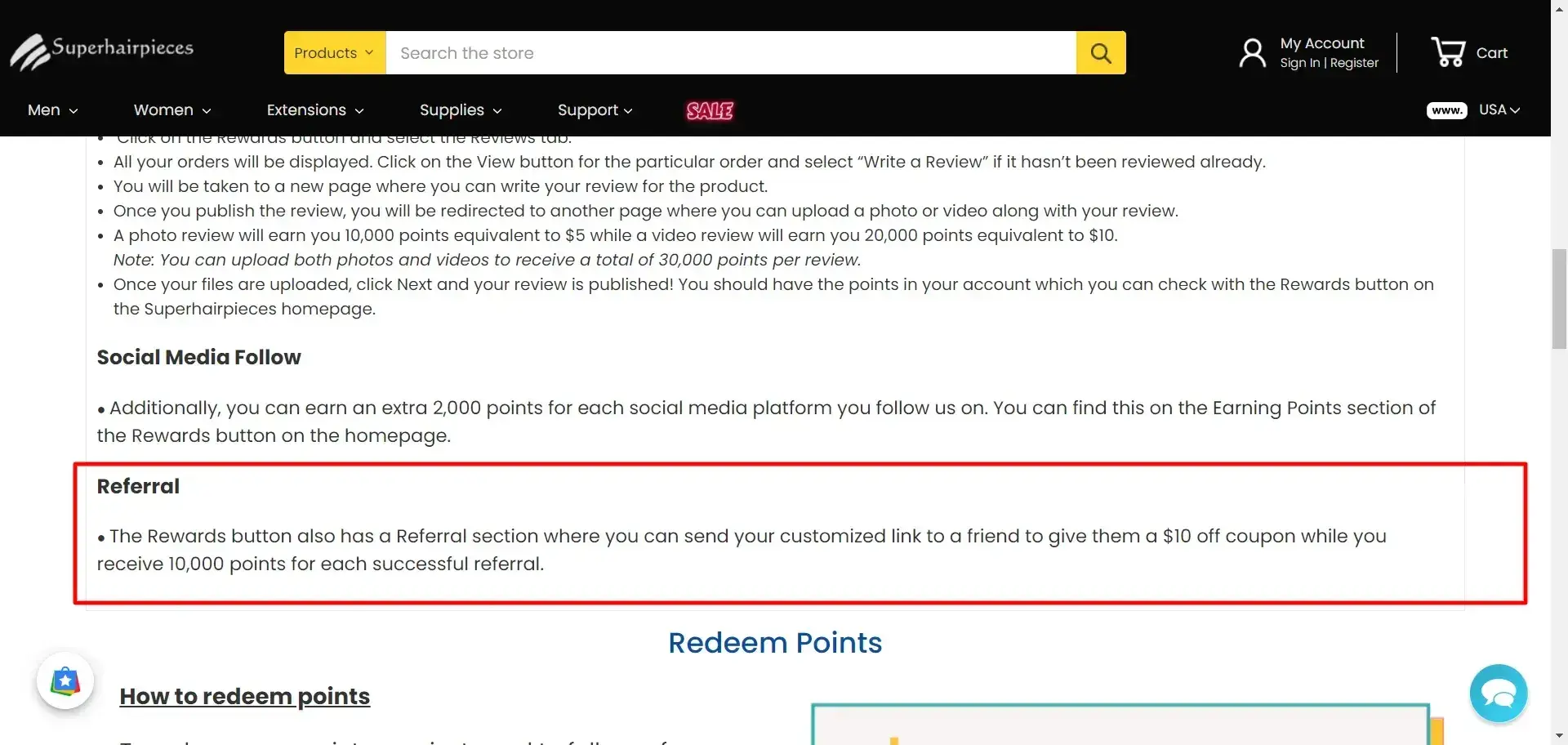
So, referral programs contribute to an increase in the loyal customer base.
Next, if you’re ready to start leveraging word-of-mouth at your business, read on for ideas and examples of customer referral programs.
Customer Referral Program Ideas
1. Contests or Giveaways
If structured correctly, contests or giveaways can not only incentivize customers to refer new leads but also create excitement around your brand.
For example, you can run a contest in which customers earn an entry by referring a set number of leads to your business, such as by submitting emails or generating signups for a free trial.
One risk with contests is attracting low-quality leads. If participants refer random acquaintances rather than genuinely interested prospects, your marketing team will waste time filtering out unqualified contacts.
To avoid this, I recommend structuring your contest to reward quality over quantity. You can ensure quality by making contest entries dependent on conversions rather than just referrals.
If a customer wants to be entered into the contest, they need to get people to sign up for or purchase your product rather than simply providing an email. This way, you’re not just generating leads — you’re attracting engaged prospects who are more likely to convert.
Why It’s Effective
This strategy is effective because it appeals to our inherent desire to win something. It might be a free product or subscription to a service, or it could even be a cash prize.
By giving away something customers want for their help in finding quality referrals, businesses can zero in on their target market.
Who It’s Best For
This approach works for any business, so long as you have something worth giving away. Retail brands could give away a high-quality, high-value item, while service companies could offer to cover the cost of services for a month, six months, or a year.
How to Measure the Program’s Success
Measuring success means making sure that customer referrals are driving quality referrals and conversions. As a result, it’s worth tracking the amount spent on contest prizes versus the volume of spending driven by referred customers.
When to Implement It
It’s worth implementing this strategy when referral numbers start to dip. The caveat? Only run it for a fixed period of time — such as two weeks or 30 days — to keep interest high.
2. Social Gifting
It’s easier to motivate customers if they don’t feel like you’re trying to manipulate them. I recommend that you focus on creating genuine opportunities for customers to share value with their friends.
When you send out a coupon that says, “Refer five people and get 25% off,” customers know that you’re trying to get something from them and are more dubious of your offer.
Instead, you can leverage social gifting as a way to encourage referrals without directly asking for them.
Take the example below.
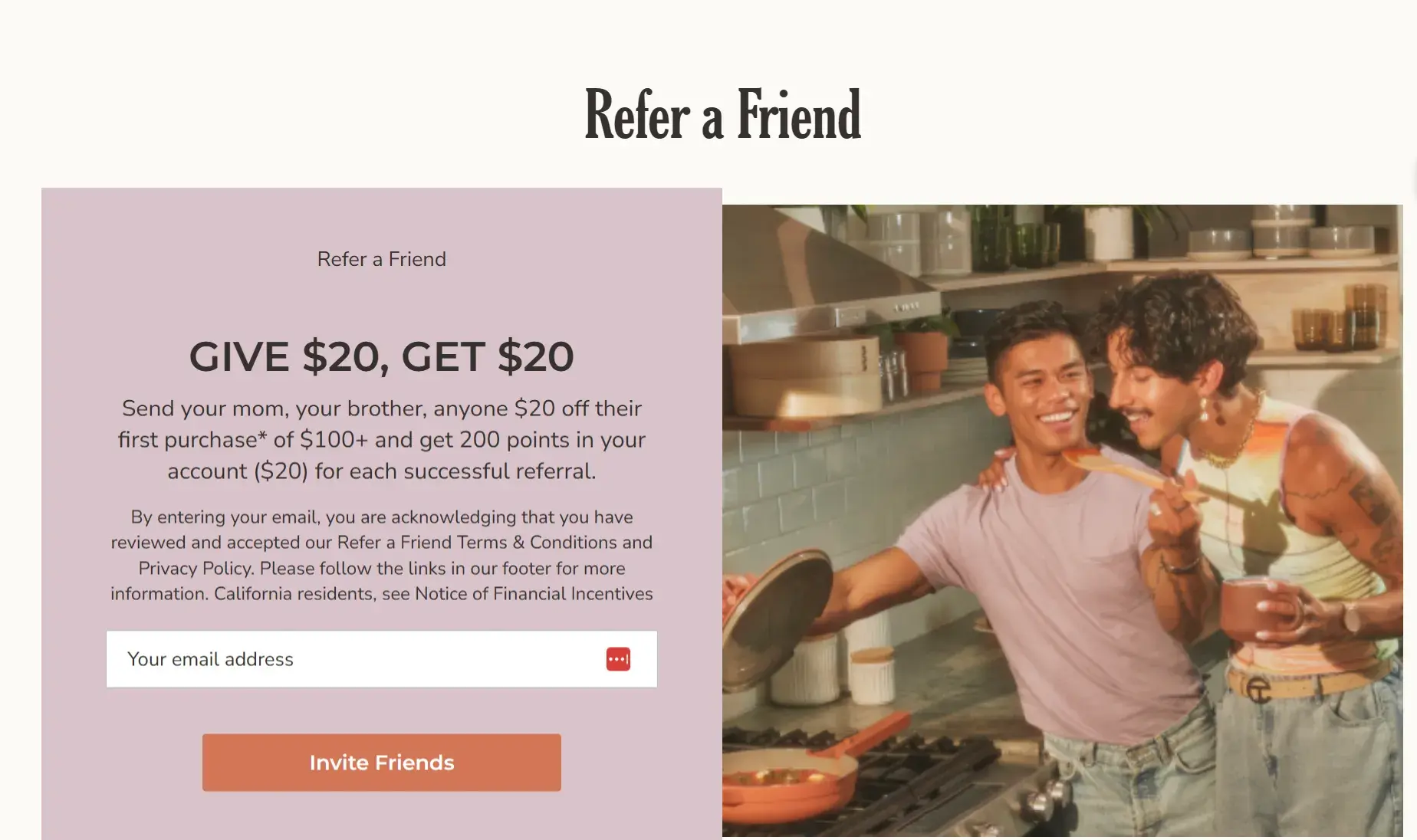
Instead of rewarding customers for providing a certain number of referrals, this offer rewards them for sharing a coupon with their peers. This way, the customer not only gets to give a gift to a friend but is also rewarded each time their referrals redeem the coupon.
That provides them with extra incentive to reach out to as many people as possible.
Why It’s Effective
Social sharing provides a way for existing customers to give and get something — and something they’ll actually use. Since you’re relying on customers to do the leg work, however, make sure that your social gift is worth their while.
The example above shows a $20 coupon for both referrer and referee; numbers lower than that, such as $5 off a purchase, probably won’t motivate action.
Who It’s Best For
Social gifting is often best for brands with a product that benefits from a specific or percentage discount. This is especially true for brands that don’t typically run sales events, as it gives customers the rare chance to get items at a lower cost.
How to Measure the Program’s Success
Use unique coupon codes or other methods to track the use of your discounts — one for current customers and one for new referrals — to make sure the program is paying off.
When to Implement It
This approach can be used any time of year for retail or ecommerce brands. One piece of advice? Make sure your giving is two-sided; both the referrer and referee should get something out of the deal.
3. Fundraisers
Fundraisers are a great way to connect with your customers’ values in a way that doesn’t involve your product or service.
By getting involved with a cause that your customers care about, you’re demonstrating that you understand more than just their buying habits. You recognize their personal values as well as what they are looking for from your business.
Additionally, fundraisers present a referral opportunity as well. It’s easy for customers to share fundraisers with their peers, and as more people donate and participate, your team will build a database of leads who share the same values as your company.
This makes it more natural for your business to follow up with these new leads and shift the conversation toward your products and services.
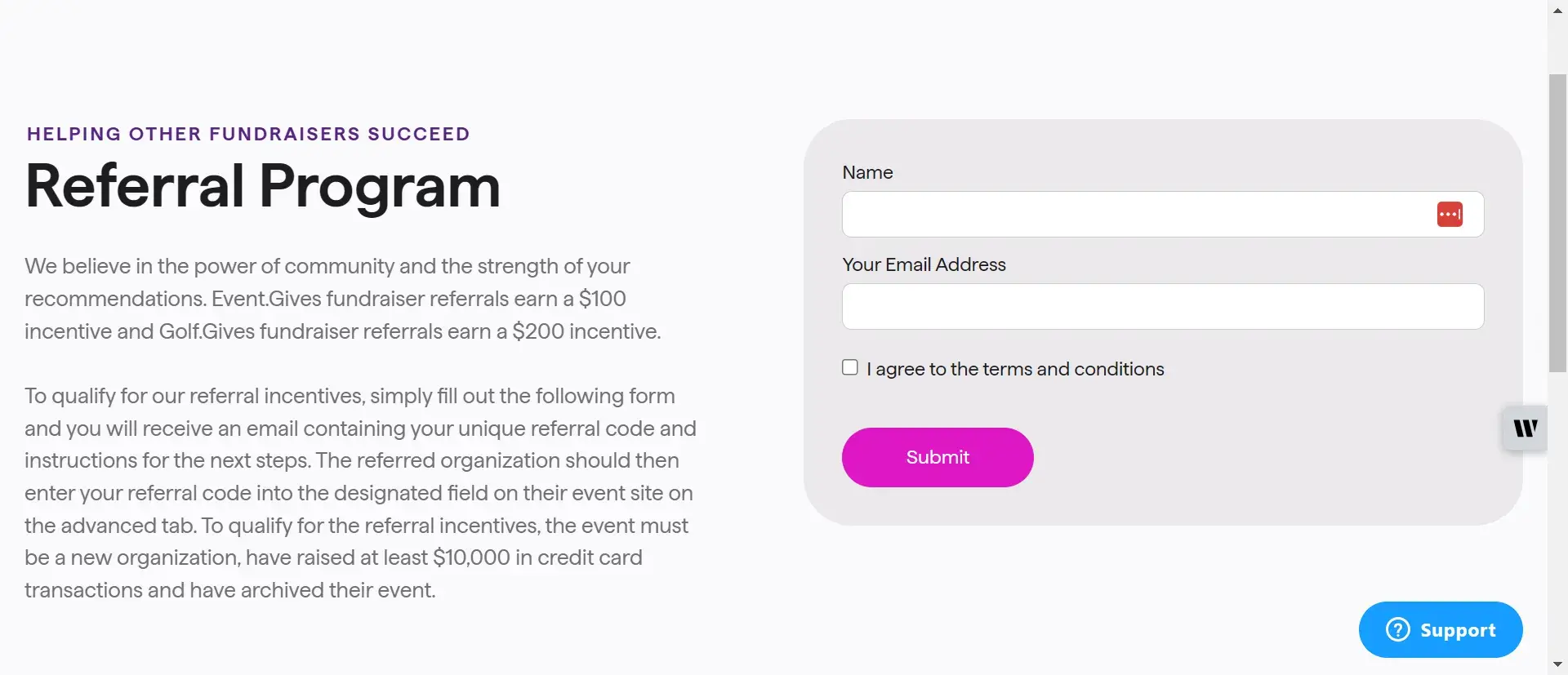
Why It’s Effective
Fundraisers take the focus off your brand and put it onto a worthy cause.
While your brand is associated with the effort — and can gain some goodwill as a result — the best fundraising efforts make sure that the cause takes top billing.
Who It’s Best For
Any company can use fundraising as a client referral program. The concept is simple: Create a fundraiser for a cause your customers are passionate about and then ask them to share the details with friends and family.
How to Measure the Program’s Success
Done well, fundraisers can bring in new customers via direct referrals. But this isn’t the primary purpose. Instead, you’re looking to build goodwill and community reputation.
As a result, you may see downstream effects when customers recognize your company name and choose to engage with your social media channels or make a purchase. Ask them where they heard about your company to get a sense of the fundraising campaign’s effectiveness.
When to Implement It
Fundraisers can happen at any time, but it may be worth aligning them with local holidays or festivals that have customers feeling more generous with their time and money.
4. Customer Loyalty Tiers
So far, I’ve discussed referral program ideas that encourage one-time referrals. While I believe these approaches are effective, I’ve observed that it’s unsustainable to host daily contests or frequent fundraisers. Instead, I recommend a more systematic approach.
For example, it’s more efficient to have a referral program that motivates customers to refer multiple people over a long period of time.
To accomplish this, you can create customer loyalty tiers that reward people as they continue to refer leads. Each tier has unique benefits. When customers refer a specific number of leads, they’re promoted to the next loyalty tier.
With this setup, customers are constantly motivated to refer new leads, even if you’re not hosting a contest or promotion.
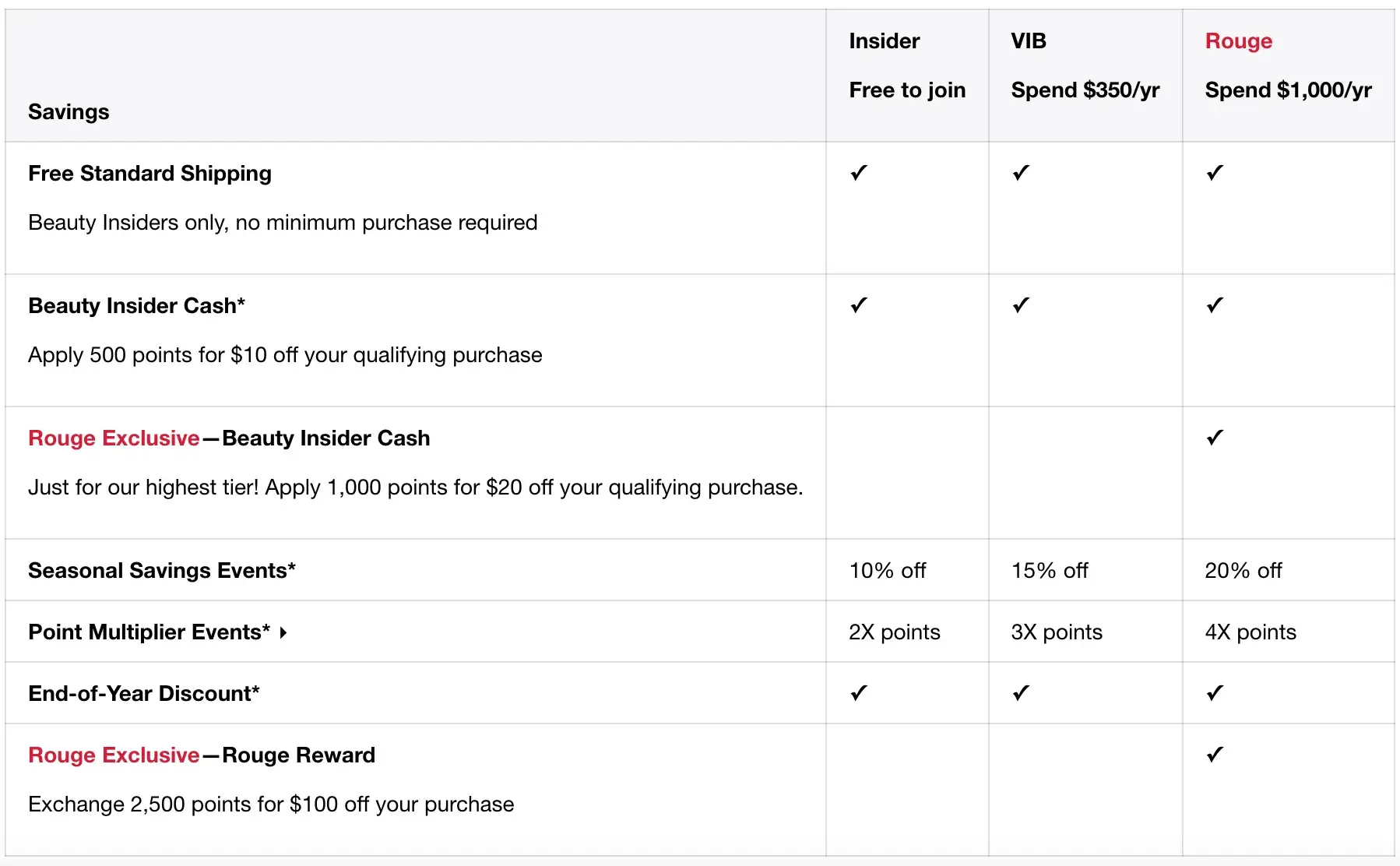
Why It’s Effective
Access to greater discounts or rewards can be a significant driver for some customers, especially if they regularly spend large amounts of money on your site or in your store.
Since these customers are already loyal, they’re more likely to sing your praises to friends and family regardless of any rewards offered. Adding a tiered referral option simply adds motivation.
Who It’s Best For
Companies that sell a large variety of products at different price points can benefit from this approach. Lower tiers may offer discounts on lower-priced items, while higher tiers could provide both money off and early access to new products.
How to Measure the Program’s Success
Measure success by tying the number of new referrals and conversions to current, high-tier customers. If you reach a saturation point where the number of high-tier members outstrips the number of conversions, consider adding a new tier or phasing out the program altogether.
When to Implement It
Implement this program just prior to a new product launch or social media campaign to help drive interest and engagement with your brand.
5. Seasonal Campaigns
I’ve found seasonal campaigns to be one of the most reliable ways to draw in new customers.
You can promote holiday discounts, annual sales, and long-term deals that can be used every year. And, if you execute these campaigns consistently, your customers will look forward to them year-round.
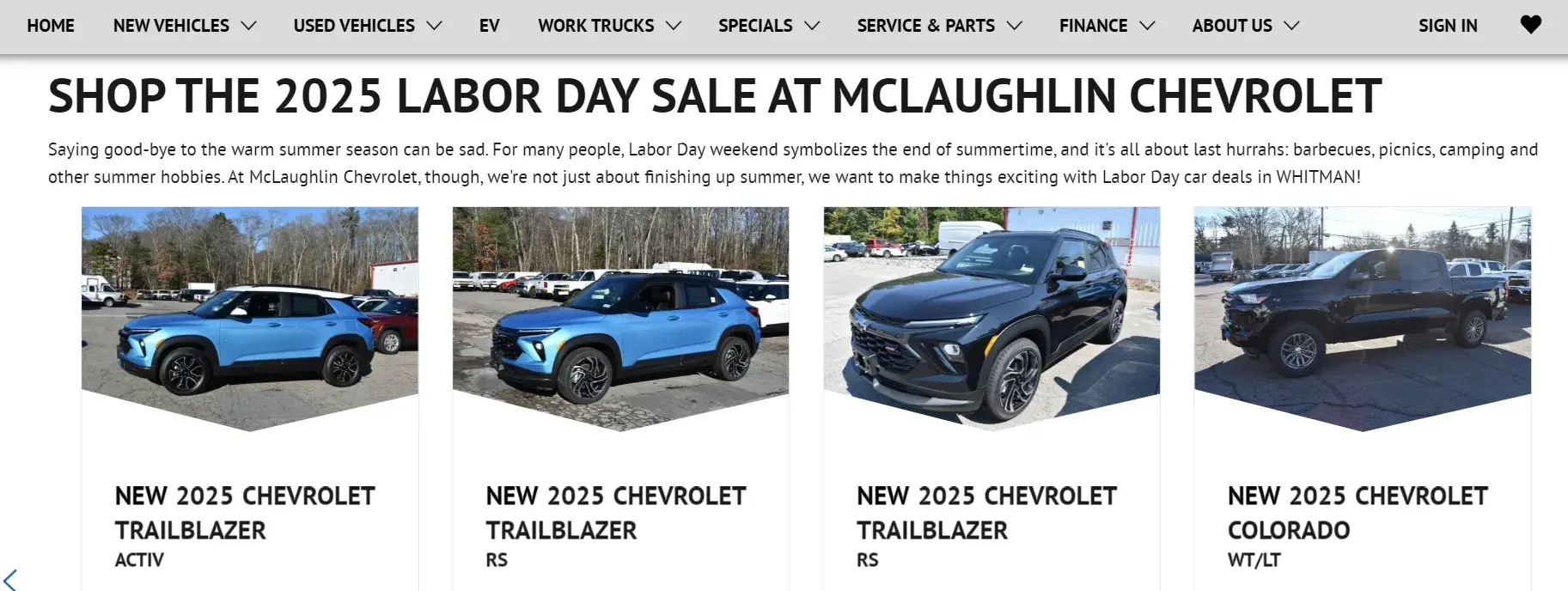
Why It’s Effective
Spending ramps up around many major holidays, making them the perfect time to capture customer attention with a great deal or discount. Do it right, and customers will look forward to your seasonal campaigns all year long — and they’ll also tell their friends.
Who It’s Best For
Seasonal campaigns can work for any product or service brand, so long as your messaging is clear and you make sure to advertise the upcoming event prior to the season or holiday itself.
How to Measure the Program’s Success
Since these campaigns happen over a fixed period of time, measuring success means comparing the number of referrals and conversions generated over the seasonal period compared to previous campaigns.
When to Implement It
Start your implementation around a month before the seasonal event itself to give customers time to think about what they want to purchase and who they want to refer.
6. Exclusive Events
From what I’ve observed about customer behavior, the desire for exclusivity is a powerful motivator.
By hosting events that are reserved for members of your customer loyalty program, you can capitalize on customer advocacy and attract new leads. These events make loyal customers feel valued, deepening their connection to your brand while naturally sparking word-of-mouth referrals.
For example, you can provide extra tickets to an event so customers can invite their peers and introduce them to your brand through a casual setting. Rather than bringing them into one of your stores, leads can attend a company outing or event where there’s no pressure to close a deal.

Why It’s Effective
Messaging from companies will never equal the impact of recommendations from friends and family.
If you can provide customers with unique experiences that introduce your brand without making it the focus of the entire event, loyal customers won’t feel strange about sharing invites with their social circle.
Who It’s Best For
This is often a great approach for B2B companies to help expand their current corporate network connections. If you can carve out a reputation as a company that hosts great events, it’s even easier for current customers to convince friends and family to tag along.
How to Measure the Program’s Success
Compare your spending on the event to the number of referrals received and the number of conversions related to these referrals.
Expect to take a loss the first few times as potential customers become familiar with your events, but if low numbers persist, consider changing your approach.
When to Implement It
Implement this strategy when calendars are fairly clear. For example, just after the holiday season is a good time — prospective referrals are often feeling a bit down and looking for an excuse to have a good time.
7. Referral Discounts
When it comes to direct incentives, I recommend considering a tiered discount system. In my view, linking larger discounts to higher numbers of referrals creates a compelling reason for customers to keep referring.
Remember, acquiring a new customer is much more expensive than retaining an existing one, so the money you lose on the discount will be made up for with the leads that you convert.

Why It’s Effective
Large enough discounts on products people want can convince them it’s worth their time to refer to their social connections and help promote your brand. The caveat? Do your research to make sure the discount you’re offering is substantial enough to drive action.
Who It’s Best For
This method works well for brands with high-value items such as electronics, jewelry, or clothing. If you can offer a significant discount for the number of referrals brought in, you’re more likely to see success.
How to Measure the Program’s Success
Remember that when it comes to client referral programs, what you lose on discounts, you make up for with new customers. Track sales from customer referrals over a specified period — for example, six months — to see if discounts are paying dividends.
When to Implement It
Consider running this type of campaign during the launch of a newer and more expensive version of your product or the debut of an entirely new product line.
8. Product or Service Upgrades
In my analysis of various referral incentives, I’ve found product or service upgrades to be particularly effective. I recommend them because they attract new leads while deepening relationships with existing customers.
If you don’t offer an upgraded product or service, you can introduce customers to beta features, products, and services that the rest of your customer base doesn’t have.
Not only will this impress customers with what your product development team has been working on, but it will also make them feel like part of an exclusive group that has VIP access to these special features.
With this approach, you’re not just offering an incentive in return for new leads. You’re encouraging customers to share positive feedback while simultaneously adding value to their customer experience over time.
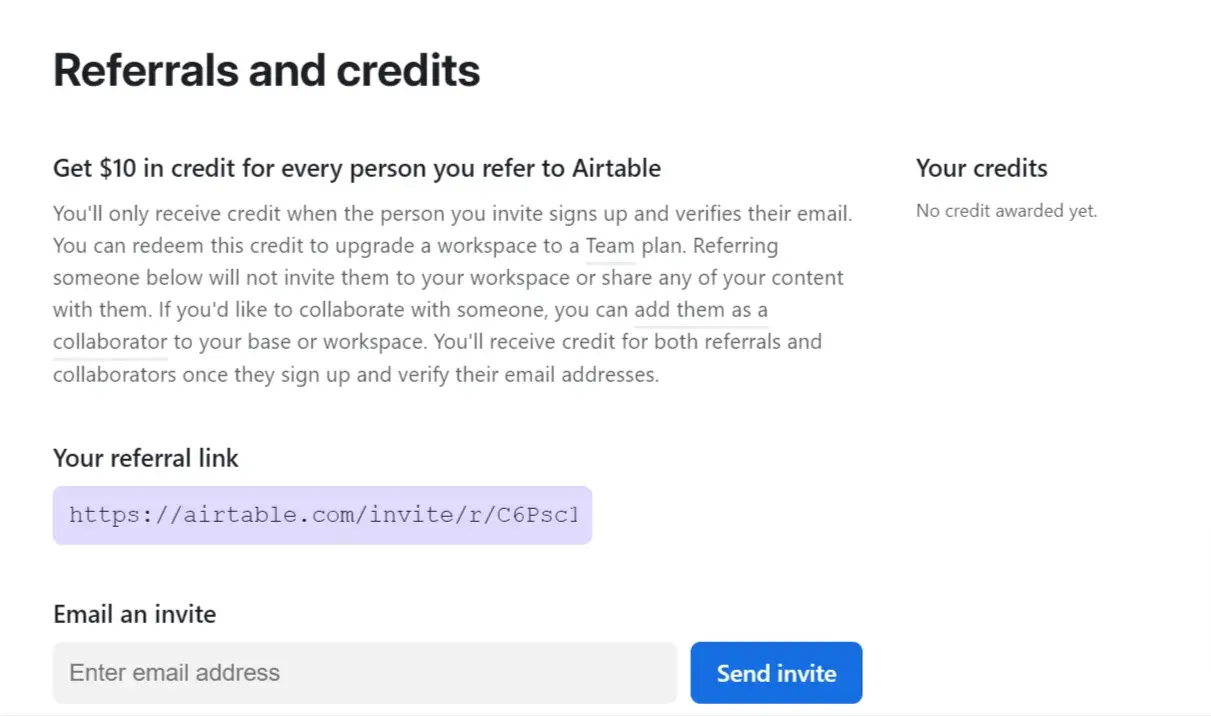
Why It’s Effective
It’s always nice to be part of the “in” group, especially if it gives you access to new services or features. Craft a stand-out experience here, and customers will be happy to praise your company.
Who It’s Best For
Service-based companies and software developers are good examples of where this approach may excel. By giving repeat customers early access to new features and functions, they feel appreciated and are excited to tell everyone else about it.
How to Measure the Program’s Success
Access to features and functions still in testing is extremely cost-effective since you’re not currently marketing these to customers. As a result, any sales that come from referrals can be considered a success.
When to Implement It
I suggest implementing this type of program whenever you roll out a new product or service. It offers free beta testing, and customers are happy to participate.
9. Charity Connections
I consider this approach particularly powerful because it combines business growth with community impact. Let me explain why I believe charity-linked referrals can be so effective.
Instead of rewarding customers with discounts or exclusive events, you partner with a local charity organization and make a donation every time an existing customer provides a new lead referral.
This is particularly useful to help build brand reputation and trustworthiness over time — both of which are now a priority for consumers.
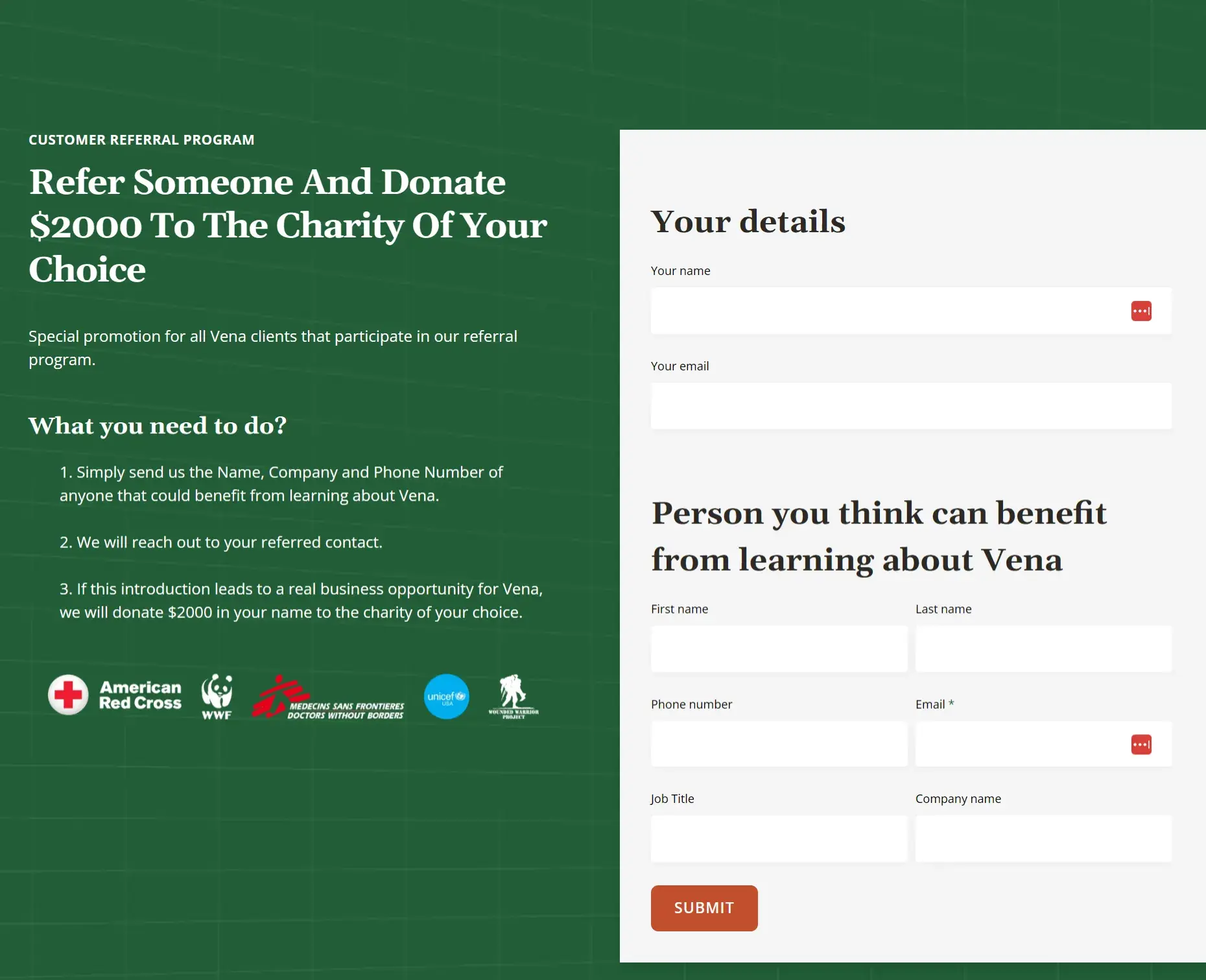
Why It’s Effective
Reputation matters for customer retention. While buyers are happy to get a discount or a free gift, if you’re willing to make a donation for every new referral, it improves their perception of your brand and, in turn, their willingness to share your campaign.
Who It’s Best For
This approach has widespread appeal. The caveat? Do your research and make sure the charity you’re donating to is one that your current customers care about.
How to Measure the Program’s Success
Since your goal here is reputation rather than direct revenue, focus on social media shares and positive online interactions with your brand. This indicates that your campaign worked, and conversions should naturally follow.
When to Implement It
While charity is a worthwhile goal any time of year, charitable giving may have more impact during or just after a crisis or high-profile event that has people looking for ways they can help.
10. Mystery Gifts
Who doesn’t love a gift?
While picking your own from a list of potential presents is great, sometimes it’s even better to get a surprise.
This is the idea behind mystery gift referrals — when current customers refer potential prospects, you send them a mystery gift. It doesn’t need to be anything extravagant, just something that shows your appreciation.
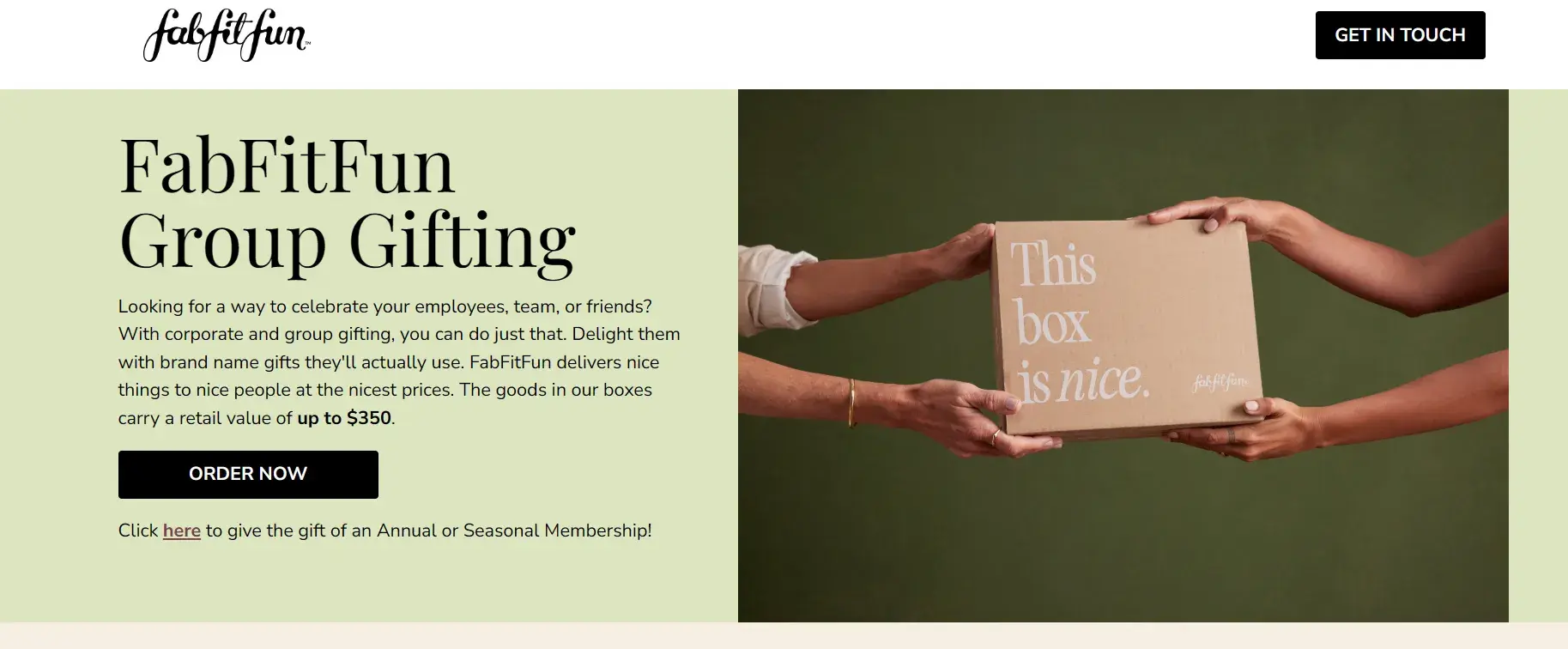
Why It’s Effective
Mystery gifts are just that — mysterious. They offer a surprise for potential referrals that may help them take action and sign up for your emails, follow your page, or start making purchases. Useful, not expensive, is the goal here.
Who It’s Best For
While any company can implement the mystery gift idea, this approach typically sees more success with retail and ecommerce brands that already sell physical products.
For example, although a software design company could send out a free gift to potential clients, it’s harder to connect this type of referral to the service being offered.
How to Measure the Program’s Success
When it comes to measuring success from mystery gifts, take a look at spending versus revenue.
If giving gifts to current customers and their referral prospects leads to enough business that you offset the cost of your gift program, keep at it. If costs consistently outpace revenue, consider another approach.
When to Implement It
Everyone loves a free gift — use this approach wherever and whenever to drive new business.
If you’re still not sure how to use these strategies, let’s look at a few companies that have successfully executed these customer referral ideas.
1. Dropbox
Dropbox offers free products or services in exchange for users referring new customers: You can earn more cloud storage space in exchange for referring a friend. I like the catchy referral slogan that Dropbox uses.
I find this approach particularly clever. While they don’t reveal the exact storage amount, I believe the promise of free storage is compelling enough to drive action.
From what I’ve analyzed, this type of incentive works because of perceived value. The idea of more storage is appealing to most users who want to have one place to securely store all their files and data.
How to Make It Work For You
- Offer something that makes existing customer accounts or services more valuable.
- Not sure? Ask customers what they’d like before spending on a referral program.
2. Acorns
When you refer a friend to Acorns, an online micro-investing service, you get $5 deposited in your account when they start investing.
It’s called Acorns because it involves investing small amounts of money to accumulate wealth, and $5 goes a long way.
Sometimes, people just want money — but especially if they’re already using a money management app.

How to Make It Work For You
- If you’re opting for money as your referral award, make sure the process from referral to deposit is clear and easy to follow.
- Make sure to highlight any restrictions, such as the number of friends that customers can refer to.
3. Hostinger
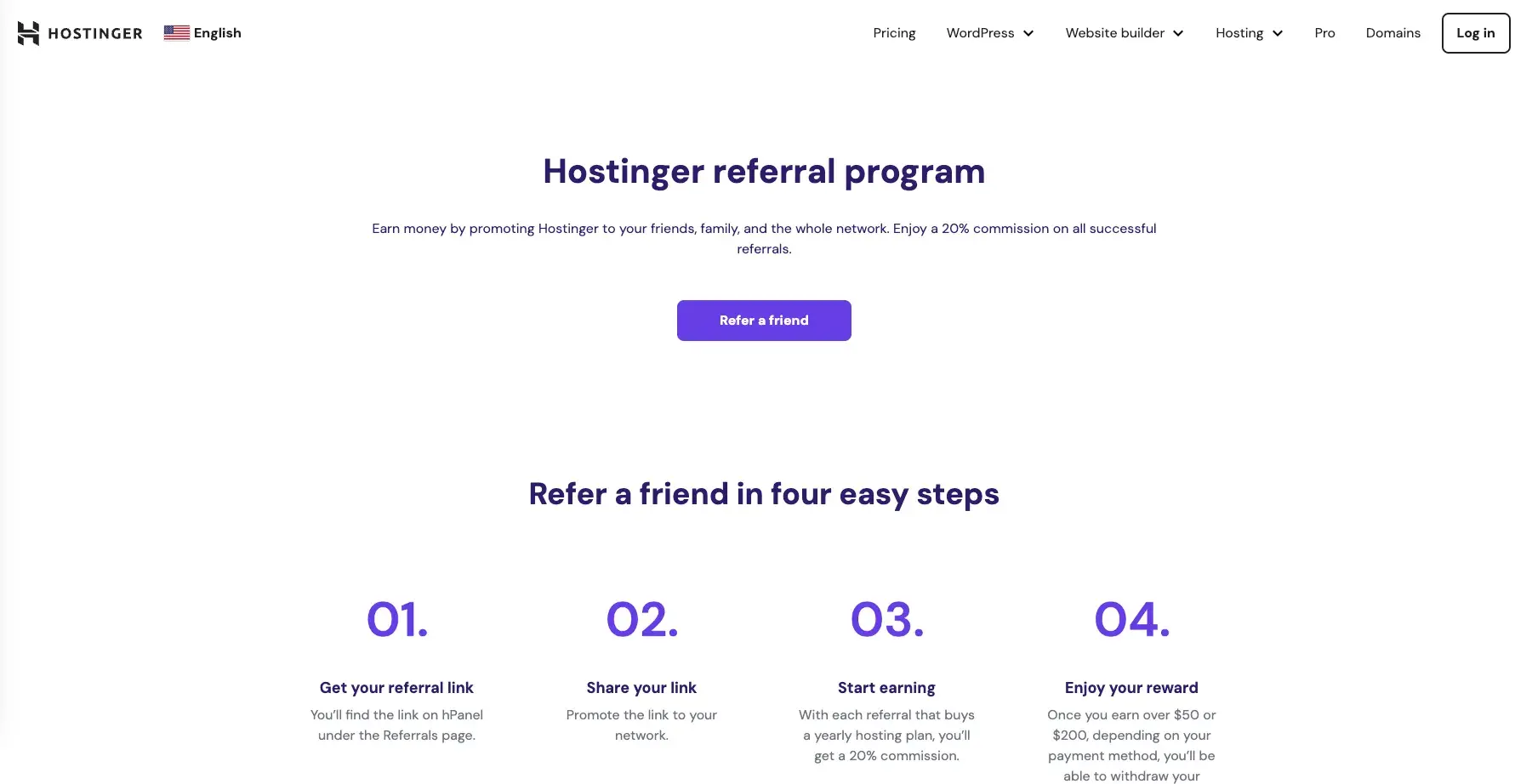
Hostinger, a globally trusted web hosting provider, allows you to earn up to $200 for each friend, family member, or colleague you refer through their referral program.
When your friend signs up for a 12-month or longer web hosting or VPS plan using your unique referral link, you’ll receive a 20% commission on their purchase. Your friend also benefits from a 20% discount automatically applied at checkout.
Your commission will be credited after your friend’s hosting plan stays active for at least 45 days. Depending on your preference, you can receive the payments from Hostinger via PayPal or wire transfer.
How to Make It Work For You
To ensure your referral program succeeds, offer generous discounts to referred customers and competitive commissions to those who refer. Keep the process straightforward so everyone understands the value for both themselves and their friends.
4. Stitch Fix
When you refer a friend to Stitch Fix, an online styling and shopping service, you get a credit on your next order.
It’s an easy step to go from telling someone where you got your outfit to sending them a link to try it themselves, so pairing that with a compelling credit or discount makes this program successful.
I liked this example since it directly asks for referrals from the customers. The referral also comes with a slogan that asks for curating the items and recommendations from the stylist.
How to Make It Work For You
- If any of your services are fee-based, waiving them is a great starting point. The caveat? Make sure it’s enough to cover something for customers so they feel like they’re coming out ahead.
- Keep it simple, especially if your program has several components. Consider creating a referral program website that explains the process in detail.
5. T-Mobile
I want to highlight T-Mobile’s approach here because I think it’s particularly effective. Their structure, which offers up to $50 per friend and caps at $500 annually, is what I consider a well-balanced referral program.
How to Make It Work For You
- T-Mobile’s referral program depends on the quality of service. If you have a service-based business, make sure you make current customer satisfaction a priority before branching out into referrals.
- Opting for a multi-referral process lets current customers earn substantive rewards — this often drives better results than a single, large-payout referral.
6. Healthy Paws
Healthy Paws pet insurance has a client referral program that donates $25 to homeless pets on behalf of referrers when referrals are completed.
It’s a smart choice to offer this type of referral for an animal-focused insurance business — the compassionate nature of the reward is likely to attract both current clients and new customers alike.
The slogan or message of this referral program is strong enough to entice the visitor to donate and refer to their known ones.
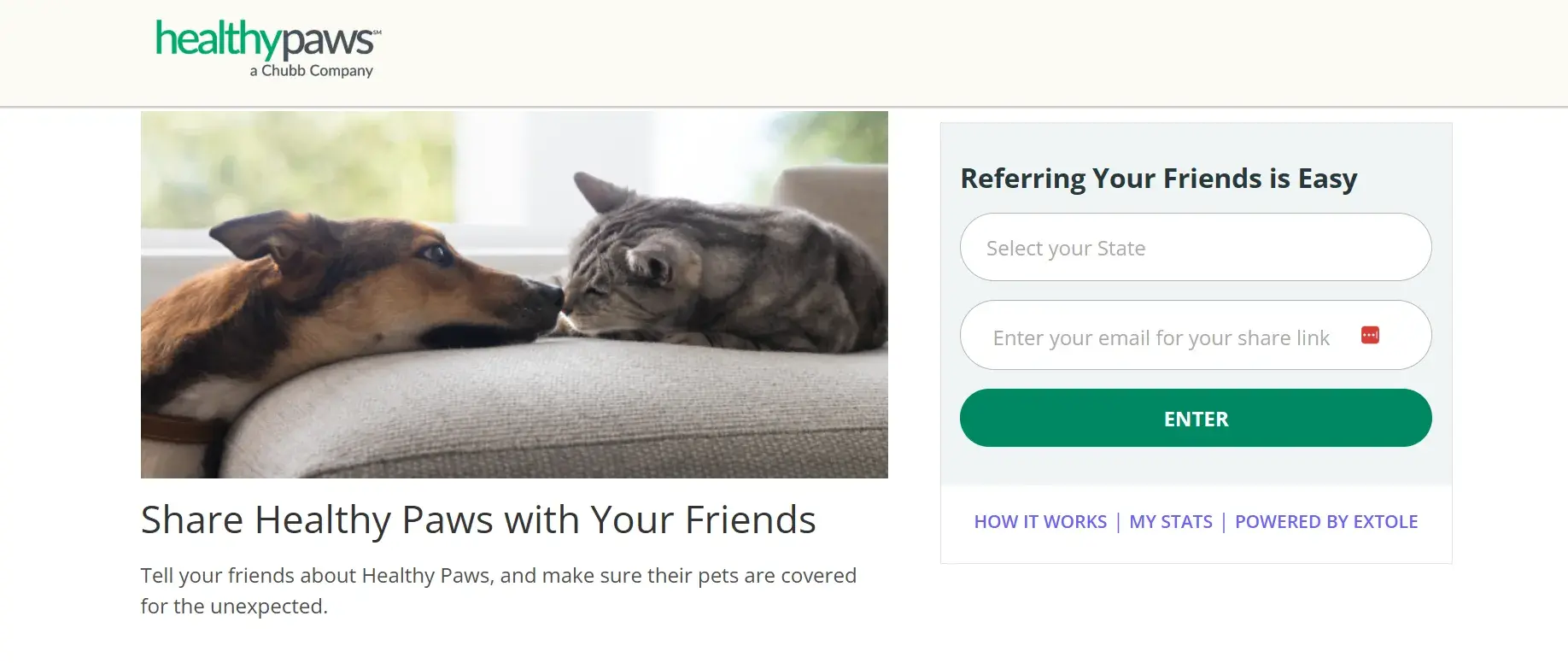
How to Make It Work For You
- This type of program is great for encouraging referrals and gaining social capital for compassionate giving. The caveat? Carefully select charities or nonprofits to ensure they’re legitimate.
- Be upfront about what charities do and the amounts they’ve raised — feature them on your website and regularly review them to make sure money is spent responsibly.
7. MeUndies
Online underwear company MeUndies offers a win-win situation for customers who like their product: New buyers get 40% off their first order, and existing customers get $25 off their next order.
Here’s how it works: Customers with an active account and at least one purchase can generate a referral link and send it to friends. When friends use the link to make a purchase, the 40% discount is automatically applied, and existing customers get a $25 credit on their account.
I consider this a masterclass in customer referral program design. It’s simple to understand, easy to share, and offers clear value to both parties.
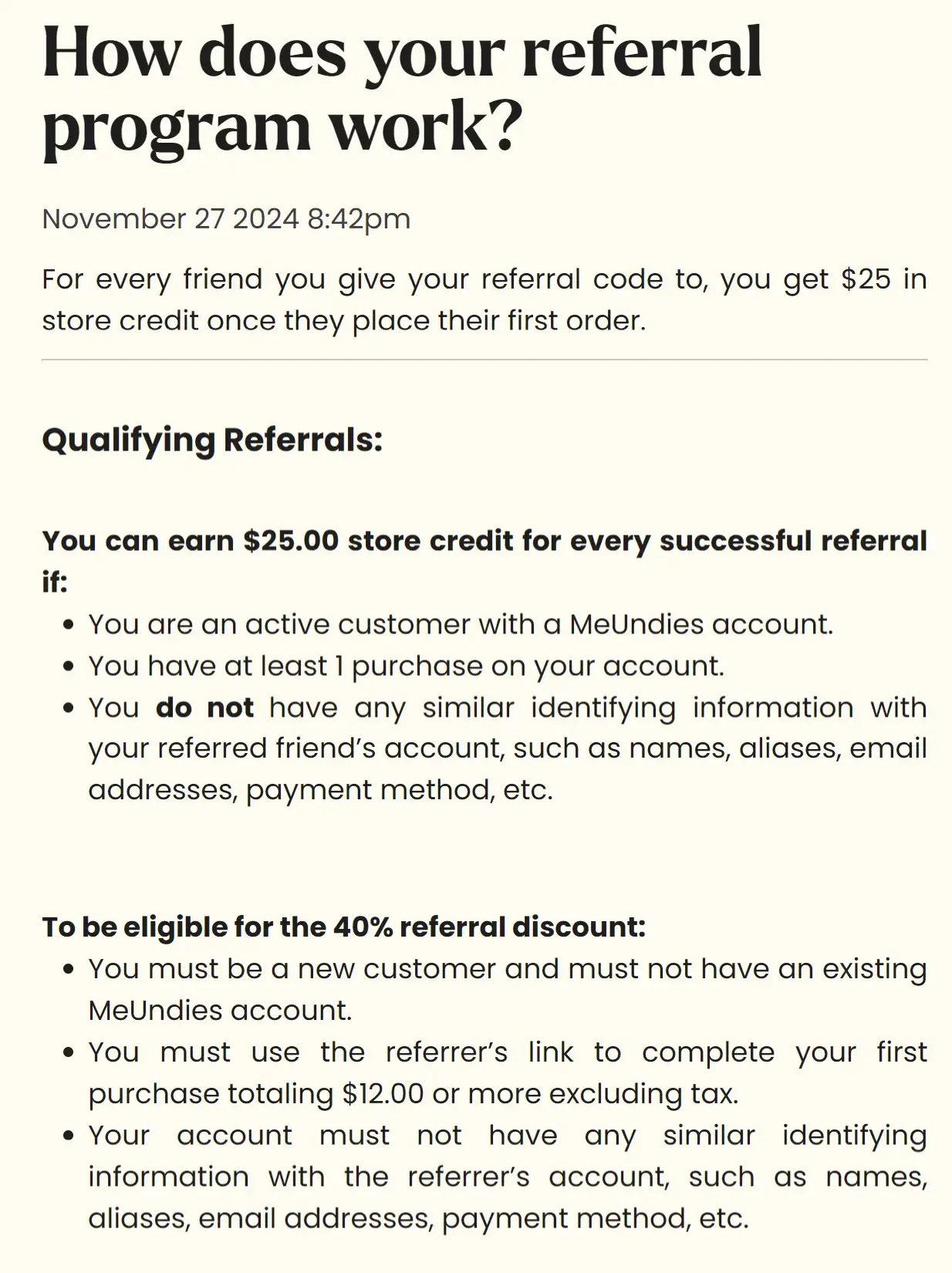
How to Make It Work For You
- In the case of more niche products like underwear, your referral program depends on the quality of your product, so it’s worth cultivating a loyal customer base before rolling out a widespread referral campaign.
- Companies like MeUndies also charge a premium price for their product — for similar brands, I think it’s critical to offer a substantive discount, such as 25% or more on the first order, to capture new customer attention.
8. Google Workspace
Search giant Google also has a customer referral program that offers cold, hard cash for bringing new users into the fold.
Existing Google Workspace customers simply sign up and get their referral link, which they send to friends or colleagues.
Unlike many other programs, however, Google doesn’t bother with discounts or free gifts — if new customers use referral links, referring customers get a monetary reward deposited directly into their bank account.
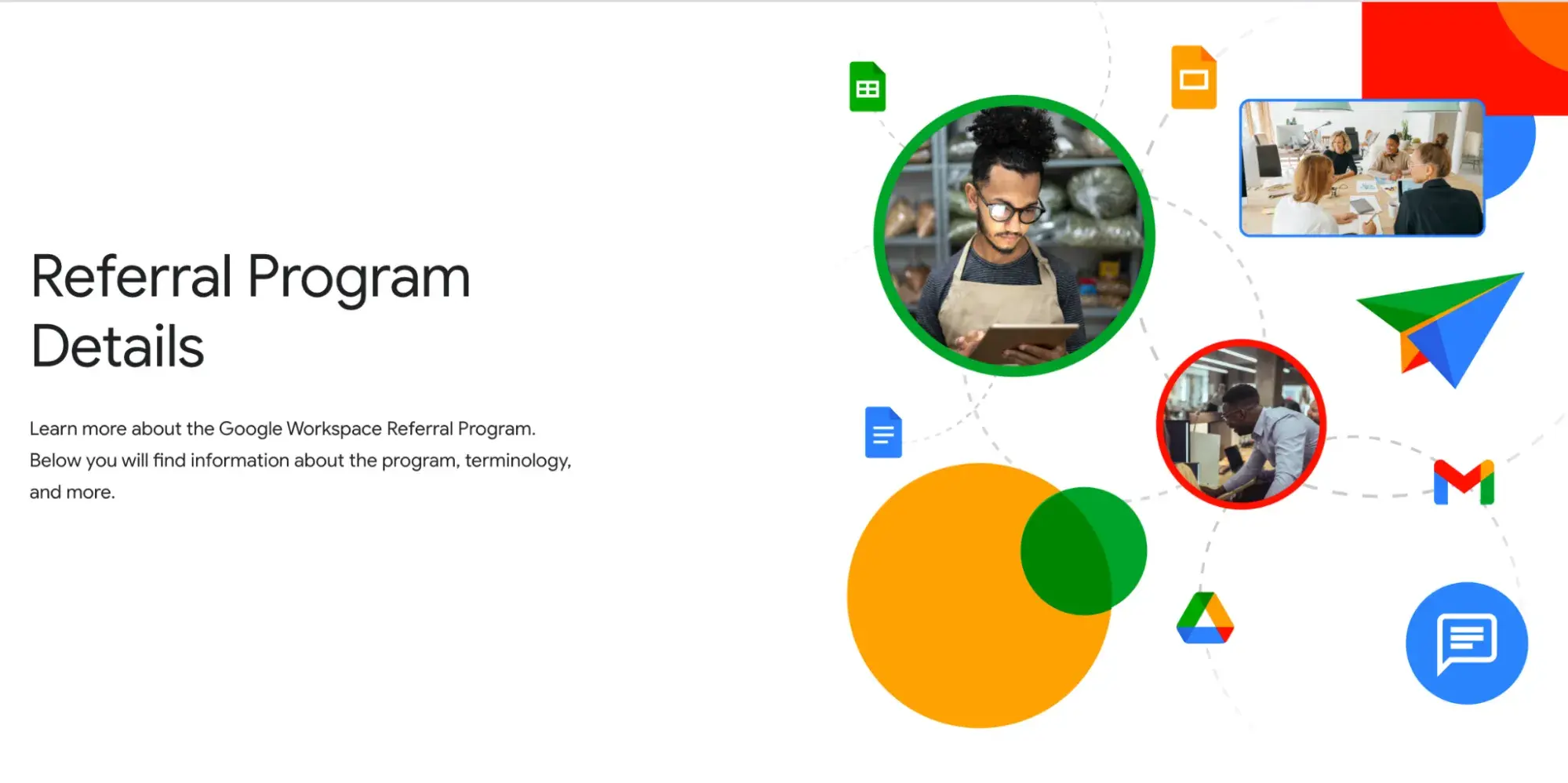
How to Make It Work For You
- This program targets workers and their colleagues, which makes function the key connector. Since employees are less likely to rave about productivity software or business apps to their co-workers, your product needs to stand out from the crowd.
- Consider a tiered reward model. Google offers differing cash amounts depending on the type of product referred.
9. DoorDash
Food delivery company DoorDash is always looking for new drivers, and their client referral program is designed to target areas where demand is highest.
Current drivers can check their app to see if drivers are needed in their area — if so, they’ll see a “Refer Friends” banner at the top of their screen.
They can then send referral links to friends looking to become DoorDash drivers — when these new drivers complete the required number of deliveries, both referrer and referee can earn cash bonuses.
Worth noting? The amount earned scales with current demand. In high-demand areas, new “Dashers” and those who refer to them could earn up to $1,000.
Current drivers can also refer up to 15 new drivers.

How to Make It Work For You
- The DoorDash program is based on demand. If you’re a service-driven business, this is a great way to generate interest. The key to success? Aligning your rewards with local needs to drive growth where you need it.
- DoorDash also encourages referees to work quickly — if targets aren’t met before bonuses change, they don’t receive the full amount. This can be a great way to drive interest, but make sure you’re up-front about how the program works.
From Customers to Champions: Unlock the Power of Referrals
I find it fascinating how the most powerful marketing tool isn’t a fancy ad campaign or viral social post — it’s the simple act of one person telling another, “Hey, you should try this product/service.”
Remember how we started this discussion talking about trust and human nature?
Well, after diving deep into referral programs, I’m even more convinced that harnessing this natural behavior is key to sustainable growth. What excites me most about referral marketing is its simplicity: When done right, it creates a perfect cycle where everyone wins.
From Dropbox’s clever storage rewards to DoorDash’s dynamic bonus system, I’ve seen how creative incentives can transform satisfied customers into passionate brand advocates.
But here’s what really stands out: The most successful referral programs aren’t about quick wins — they’re about building genuine relationships that compound over time. Whether you start with simple social gifting or implement a fully-fledged tiered rewards system, the principles we’ve covered today will help you create a program that drives growth and strengthens your customer community.
Editor's note: This article was originally published in March 2018 and has since been updated for comprehensiveness.
Customer Acquisition
.png?width=112&height=112&name=Image%20Hackathon%20%E2%80%93%20Vertical%20(11).png)

.png)

![7 Customer Acquisition Challenges You Might Face This Year [New Data]](https://53.fs1.hubspotusercontent-na1.net/hubfs/53/customer%20acquisition%20%20(1).webp)







